Zinc is an essential metal ion but at elevated concentrations it can be toxic and has inhibitory effects on cell activities. There are many industries along Karun river’s bank (longest river in Iran) discharging their zinc containing effluents to this river. The objectives of the present study were isolation and identification of zinc resistant bacteria from water and sediments of Karun River and study their growth kinetics. Sampling were done from water and sediments of 4 stations in 3 seasons, summer, autumn and winter. Zinc content of samples was measured by atomic absorption spectrophotometer. Bacterial numbers were count in both medium containing and without zinc. Bacterial isolation was performed by primary enrichment and direct plating methods. Isolates were examined for their resistance and growth kinetics in presence of zinc. Bacterial number was obtained 4.278 in medium containing zinc that was higher than control medium without zinc. Pseudomonas sp., Escherichia coli, Salmonella sp., Citrobacter sp. were isolated as zinc resistant bacteria. Some of these bacteria were able to tolerate 1000 mg/l of zinc. The maximum zinc uptake was found to be about 68% by Pseudomonas sp. Results of this experiment showed that presence of zinc cause growth cease of many bacteria. Using primary enrichment method compared with direct plating caused better isolation of resistant bacteria. Isolated bacteria were able to remove zinc metal.
Zinc resistant bacteria, Bioelimination, Heavy metals, Karun River
© The Author(s) 2013. Open Access. This article is distributed under the terms of the Creative Commons Attribution 4.0 International License which permits unrestricted use, sharing, distribution, and reproduction in any medium, provided you give appropriate credit to the original author(s) and the source, provide a link to the Creative Commons license, and indicate if changes were made.


